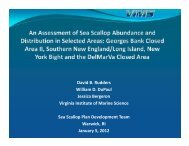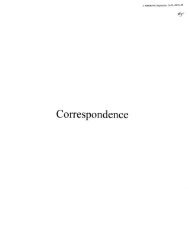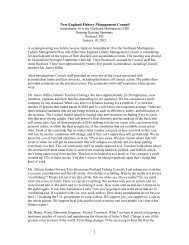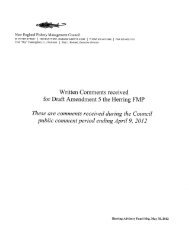Smooth Bottom Net Trawl Fishing Gear Effect on - New England ...
Smooth Bottom Net Trawl Fishing Gear Effect on - New England ...
Smooth Bottom Net Trawl Fishing Gear Effect on - New England ...
Create successful ePaper yourself
Turn your PDF publications into a flip-book with our unique Google optimized e-Paper software.
NOAA/NMFS Unallied Science Project, Cooperative Agreement NA16FL2264 May 2005<br />
<str<strong>on</strong>g>Smooth</str<strong>on</strong>g> <str<strong>on</strong>g>Bottom</str<strong>on</strong>g> <str<strong>on</strong>g>Net</str<strong>on</strong>g> <str<strong>on</strong>g>Trawl</str<strong>on</strong>g> <str<strong>on</strong>g>Fishing</str<strong>on</strong>g> <str<strong>on</strong>g>Gear</str<strong>on</strong>g> <str<strong>on</strong>g>Effect</str<strong>on</strong>g> <strong>on</strong> the Seabed:<br />
Investigati<strong>on</strong> of Temporal and Cumulative <str<strong>on</strong>g>Effect</str<strong>on</strong>g>s BKAM/CR<br />
1.2 Project Goals and Objectives<br />
The objective of our 2002 study was to provide targeted weekly trawling pressure (chr<strong>on</strong>ic<br />
impact) over a number of m<strong>on</strong>ths <strong>on</strong> established experimental trawl corridors at two sites (Little<br />
Tow and Mud Hole) historically subjected to different trawling pressure in the Gulf of Maine off<br />
Scituate, MA. Replicate reference and experimental corridors at the two sites were sampled prior<br />
to trawling, and at two latter times during the chr<strong>on</strong>ic trawling to investigate any discernable<br />
cumulative impacts <strong>on</strong> the generally soft bottom habitat at the study areas.<br />
A number of comp<strong>on</strong>ents of the 2002 study fell within the fisheries management informati<strong>on</strong><br />
need. In particular,<br />
(1) C<strong>on</strong>ducting fishing industry-supported high-resoluti<strong>on</strong> sediment mapping in areas of the<br />
western Gulf of Maine (i.e. Little Tow and Mud Hole);<br />
(2) Identifying biological communities (pelagic, epifaunal, infaunal) associated with the<br />
mapped areas and determining relati<strong>on</strong>ships between the soft bottom sediment type and<br />
these communities; and<br />
(3) Examining and comparing commercially important fish species and benthic biological<br />
communities in soft bottom habitat in both heavily and lightly fished reference areas and<br />
how they resp<strong>on</strong>d to the cumulative impact of trawling with a smooth bottom trawl net.<br />
More specific areas of investigati<strong>on</strong> addressed by this report include:<br />
• Ground truthing existing bathymetric and sediment maps of an area of EFH using<br />
side-scan s<strong>on</strong>ar, video, precisi<strong>on</strong> bathymetric mapping, sediment profile imaging, and<br />
benthic sampling technologies;<br />
• Observing acute and cumulative impacts of traditi<strong>on</strong>al soft bottom trawl gear, and<br />
m<strong>on</strong>itoring these impacts over several m<strong>on</strong>ths;<br />
• Using statistical methods to correlate the degree of impact <strong>on</strong> benthic and demersal<br />
organisms between trawled and nearby untrawled ‘reference’ areas;<br />
• Observati<strong>on</strong> of fish and invertebrate species, particularly juvenile finfish, and their<br />
dependence <strong>on</strong> seabed structure for shelter; and<br />
• Observati<strong>on</strong> of the relative severity of impact attributable to the various comp<strong>on</strong>ents<br />
of the trawl gear system.<br />
One of the primary goals of the 2002 repetitive trawling experiment was to provide meaningful<br />
data for l<strong>on</strong>g-term management of soft sediment ecosystems. The experimental treatment is<br />
designed to more closely resemble current trawling disturbance activity in intensity, as well as,<br />
spatial and temporal scope. In additi<strong>on</strong>, this project should improve EFH designati<strong>on</strong> in soft<br />
3







